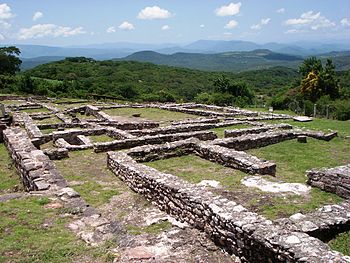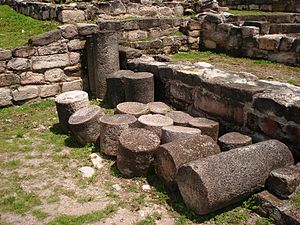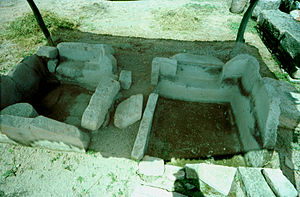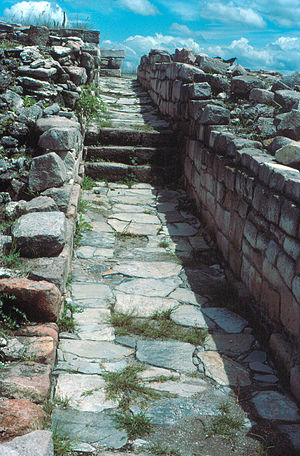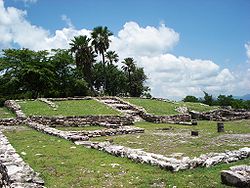- Cuetlajuchitlán
-
Mezcala Culture – Archaeological Site Name: Cuetlajuchitlán archaeological site Type Archeology Location Paso de Morelos, municipality of Huitzuco de los Figueroa, Morelos
 Mexico
MexicoRegion Mesoamerica (México) Coordinates 20°33′03″N 100°26′33″W / 20.55083°N 100.4425°WCoordinates: 20°33′03″N 100°26′33″W / 20.55083°N 100.4425°W Culture Cuitlatec - Mezcala Language Cuitlateco Chronology 800 a.C. – 300 d.C. Period Mesoamerican Late Preclassical INAH Web Page Conaculta page Cuetlajuchitlán (Los Querendes) "'Cuetlajuchitlán"' is a mesoamerican archaeological site located 3 kilometers southeast of Paso Morelos, northeast of the State Guerrero, Mexico.
It was discovered in 1991 duringg construction works of the highway from Cuernavaca to Acapulco that crosses 50 meters below (through a tunnel) "Los Querendes".
This site was one of the main prehispanic population centers in this region during the late preclassical, of groups deriving from the Mezcala culture, in the large settlements of the Rio Balsas. Its development occurred from 800 BCE to 300 CE, with relevance to archaeology of the Guerrero state, due to its antiquity and functional architectural style, primarily for the storage and drainage systems, as well as the construction of stone columns.
Contents
Toponymy
Paso Morelos was formerly known as Cuetlajuchitlán or Cuetlajuchi.[1]
The word Cuetlajuchitlán formerly given to the original population, and now used for the archaeological zone site, is a Nahuatl word that means: "Place of red flowers" or "Withered place".[1]
It may be that the "red flower" is in allusion to Poinsettia, native to the region.
Archaeological Site
The site extension is about 35 hectares, of which only two have been explored; sites already uncovered are located on a limestone hill, where the late Preclassical period settlements were found.
Cuetlajuchitlán, during its apogee had three constructive stages, over a period of about 900 years. These are:
First Stage
The first (800-600 BC) found very few archaeological remains were found during excavation.[2]
This stage is characterized by limestone rocks walls that make up leveling platforms as well as housing foundation, figurines and some pots found. These materials show that the site was then a small village - perhaps dependent on a larger Olmec related culture (Mezcala) settlement in the Balsas River region during the mid-preclassical (800-1000 BCE), or as it seems more likely that it was inhabited by people who settled here around 600 BCE, at the decline of the Olmec sites.[2]
Second Stage
During the period of 200 BCE to 200 CE, Cuetlajuchitlán flourishes, this is characterized by the abundance of objects of ceramic, which were dated to the late preclassical; also found in one of the corridors, sculptures carved on Tuff blocks, worn out by time. From this begins the architectural development of the site, limestone blocks and cylinders carved for its construction in columns and walls, all very well defined in its manufacturing.
Third Stage
This stage continued with development of buildings, whose material from previous constructions was reutilized, these included the column blocks column and Metates. Limestone walls are associated with the Mezcala culture style, this feature of around 300 CE, sets the decadence y abandonment of Cuetlajuchitlán.
Site Description
The site has a complex architectural distribution, with stone slab streets, large platforms, open spaces and others that functioned as rooms, warehouses or possibly as workshops where specialized activities were performed. From the architectural design, it can be inferred that elite groups lived here; they controlled communal activities and performed public and ceremonial activities.[2] The site has several function places, these include two ceremonial places and three residential housing complexes, it is believed were occupied by high ranking people and craftsmen. The most important Cuetlajuchitlán buildings, in the two explored complexes are:
Ceremonial Place 1
This is the main structure of the site, it is rectangular and measures 28 m, north–south and 18 m east-west. Its large platform, sunken patio and walls, were built with limestone blocks; two pink tubs carved from a single block were found here, probably used for ritual baths. These baths have a seat on the west side, with an external design resembling an eyebrow, similar to the constructive style of the area. Close the main platform is a Temazcal or ancient steam bath.
Ceremonial Place 2
Situated next to ceremonial place 1, at the southeast end with an enclosed small space; It also has two tubs that probably were used before the enclosure construction. As evidence, its construction materials were reutilized in an area used for rectangular and circular pink stone block carving and storage, and later used for building construction.
Structures
Residential Housing Complex
These were places inhabited by high hierarchical level people, located in the northern, southern and western slopes of the hill. Features the street continuation on axes distributed around well-defined platforms, pink limestone room were built with sunken patios and their respective drainage system, water tanks and small storage areas.
Complex 8
Located some 200 meters outside the area previously explored, it is a vast complex consisting of a square surrounded by platforms with housing units which in turn had their respective water tanks and a water channel. The center has a great platform where probably was placed the house of an elite leading member, who probably ruled Cuetlajuchitlán at a point in time.
Storage areas
In several ports of the site are some constructions with shape and dimensions similar to storage areas, possibly for grain, food or manufactured products. These underground deposits were built with limestone walls and floor slabs. An important amount of ceramic pots fragments were found in these.
Site Access
The site is located at kilometer 188 of the Cuernavaca - Acapulco highway, 3 kilometers southeast of Paso Morelos, Huitzuco de los Figueroa, where is an Access to the site. Site visits are Tuesday through Sunday from 10:00 to 17:00.
Other Sites in the municipality
Cerro de Huashocote
Located north of the municipality.[3]
Tlaxmalac
Located to the west, it is a rock with a carved head, faithful testimony of culture.[3]
Barrio Cantón
During excavations, many ceramic and stone figures were found in original conditions.[3] [3]
La Maroma
Located to southeast, also found ceramic and stone idols as well as a jade mask objects.[3]
Other sites in the region
- Teopantecuanitlán, in Copalillo.[4]
- La Organera, in Xochipala[4]
- Huamuxtitlán, in the municipality of the same name.[4]
- Los Tepoltzis, in Tixtla[4]
- Ixcateopan, in the municipality of the same name [4]
- La Sabana and Palma Sola, in Acapulco[4]
- Pezuapan, in the municipality of the same name[4]
- La Soledad de Maciel, in Petatlán[4]
- Oxtotitlán, in Chilapa[4]
- Tehuacalco, between this municipality and Juan R. Escudero[4]
Notes
- ^ a b "Bienvenidos a Paso Morelos [welcome to Paso Morelos]" (in Spanish). Sitio oficial de Pasoo de Morelos. February 2010. http://pasomorelos.com/. Retrieved Nov. 2010.
- ^ a b c Manzanilla López, Rubén -, Talavera González, Jorge Arturo. "[Cuetlajuchitlan, pre-urban Mezcala region site]" (in Spanish). Cuetlajuchitlan, Sitio pre-urbano en la región Mezcala. http://www.arqueomex.com/S2N3nCUETLA82.html. Retrieved Sept. 2010.
- ^ a b c d e "Huitzuco de los Figueroa" (in Spanish). Enciclopedia de los Municipios de México. http://www.e-local.gob.mx/work/templates/enciclo/guerrero/municipios/12034a.htm. Retrieved Sept. 2010.
- ^ a b c d e f g h i j Castro, Marlen. "En 2007 sólo en Cuetlajuchitlán hubo labores de restauración, dice el INAH [In 2007, only Cuetlajuchitlán had restoration work, says INAH]" (in Spanish). La jornada de guerrero. http://www.lajornadaguerrero.com.mx/2007/12/28/index.php?section=cultura&article=011n2cul. Retrieved Sept. 2010.
See also
References
- Página Conaculta Cuetlajuchitlán (Los Querendes) (Spanish)
- Enciclopedia de los Municipios de México, Huitzuco de los Figueroa (Spanish)
Bibliography
- Manzanilla López, Rúben & Talavera González, Jorge Arturo, Cuetlajuchitlán, Sitio Preurbano en la Región Mezcala., (2006). Arqueológia Mexicana, vol. XIV, No. 82. Id = 0188-8218 (Spanish)
External links
- Cuetlajuchitlán, Sitio pre-urbano en la región Mezcala en la revista Arqueología Mexicana. (Spanish)
- Official web site Paso de Morelos town (Spanish)
Categories:- Mesoamerica
- Archaeological sites in Mexico
- Mesoamerican sites
- Former populated places in Mexico
- Archaeological sites in Guerrero
Wikimedia Foundation. 2010.

